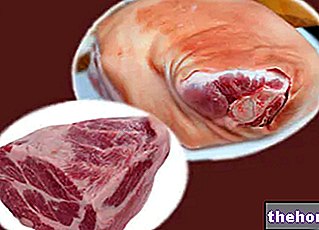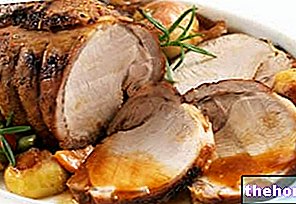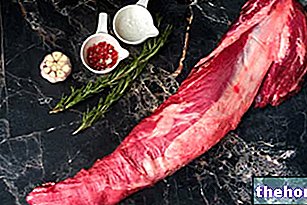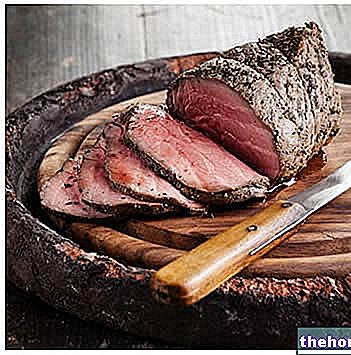
Very well known and widespread, the rump is considered by most to be the best compromise between the organoleptic and gustatory characteristics, and the cost. On the palate it is in fact very tasty but not as much as the steak, tender but not like the fillet and, compared to both, significantly lower in price.
Anatomically speaking, the rump - even if it would be more correct to speak in the plural, since each bovine has two (one on each side) - consists of the terminal portion of the lumbar muscle and the proximal portion of the upper thigh - located in the hindquarters of the beast. It has an irregular shape, which varies greatly according to the sectioning technique. The adipose tissue is mainly subcutaneous, external to the muscles, and can be easily separated
Beef rump also has decent nutritional properties. These can vary according to the subspecies or the animal race, but also to sex, age, constitution and level of workmanship. Generally, containing medium-low levels of connective tissue - despite being more stressed in the movements than the rib and especially the fillet - it is generally low in fat, tender and moderately digestible.
The rump belongs to the 1st fundamental group of foods - foods rich in proteins with high biological value, vitamins - especially water-soluble B group - and specific minerals - in particular iron. There are non-negligible levels of cholesterol, saturated fats - not prevalent over unsaturated ones - purines and phenylalanine amino acid. Very large portions of rump are not recommended, especially in case of overweight, hypercholesterolemia, hyperuricemia, phenylketonuria and digestive, liver and kidney complications.
The rump is a widely used ingredient for the preparation of main courses but it is also an optimal ingredient for excellent quality minced meat - for sauces, meatballs, hamburgers etc. It also lends itself to raw foods and intense and rapid cooking, such as grilled, grilled and possibly in a pan - it is also excellent "rare".
The overall quality of the rump can change according to the level of maturation - that sort of "mummification" that takes place in the cold room - at a low temperature but above 0 ° C - necessary to dry the meat and make it mature flavor and aroma. The process determines, on the other hand, a lower yield of the meat which, dehydrating and requiring a greater degree of husking - to discard the surface layer left in the air for about a month - loses weight and increases in cost.
with high biological value, specific vitamins and minerals. It has a highly variable energy intake according to the cases, even to an extent of 40-60%.Calories are mainly provided by proteins and lipids; carbohydrates are absent. The peptides have a high biological value, that is, they contain all the essential amino acids in the right quantities and proportions compared to the human model - the most abundant are glutamic acid, aspartic acid and lysine. Fatty acids are predominantly unsaturated, especially monounsaturated, sometimes followed almost equally by saturated ones; polyunsaturates make up the least significant portion. Cholesterol is present in significant but all in all acceptable quantities.
The rump does not contain dietary fiber, gluten, lactose and potentially troublesome concentrations of histamine. Instead, it has significant amounts of purines and phenylalanine amino acid.
From a vitamin point of view, the rump is not distinguished from the average of products belonging to the same category - meat. It mainly contains water-soluble vitamins of group B, in particular niacin (vit PP), pyridoxine (vit B6) and cobalamin (vit B12); less relevant are thiamine (B1), riboflavin (B2), pyridoxine (vit B6), biotin (vit H) and folates. Ascorbic acid (vitamin C) and all the fat-soluble acids (vit A, vit D, vit E, vit K) appear to be absent or irrelevant.
Also as regards the mineral salts, the rump does not stray too far from its group of belonging. The iron content is good, but also zinc and phosphorus; it also brings potassium.

The rump, rich in high biological value proteins, is very useful in the diet of those who have a greater need for all essential amino acids; for example: pregnancy and breastfeeding, growth, extremely intense and / or prolonged sporting practice, old age - for eating disorder and tendency to geriatric malabsorption - pathological malabsorption, recovery from specific or generalized malnutrition, defedation, etc.
For the reasonable content of cholesterol and the acceptable percentage of saturated fat, it can be used in the diet against hypercholesterolemia, provided that the portion and frequency of consumption are acceptable. Note: in dietary therapy against dyslipidemia it is however less appropriate compared to fish - finnuts proper - rich in omega 3 (EPA and DHA). It is a neutral food for diets aimed at subjects suffering from hyperglycemia or type 2 diabetes mellitus, hypertriglyceridemia and hypertension, except in the presence of severe overweight.
The rump is one of the products to avoid, or to consume in extreme moderation, in case of severe hyperuricemia - tendency to gout - and kidney stones or lithiasis from uric acid crystals. It should be completely excluded from the diet for phenylketonuria. It does not show contraindications for lactose intolerance and celiac disease; it is also harmless for histamine intolerance.
The rump is an appreciable source of bioavailable iron and participates in covering the metabolic needs, higher in fertile, pregnant women, marathon runners and vegetarians - especially vegans. Note: Iron deficiency can lead to iron deficiency anemia. It contributes to the satisfaction of the needs of phosphorus, a mineral very abundant in the organism - in particular in the bones, in the form of hydroxyapatite, in the phospholipids of cell membranes and in the nervous tissue etc. The zinc content - essential for hormonal and enzymatic antioxidant production - it is more than appreciable. The rump is not to be considered an essential source of potassium, but it nevertheless participates in satisfying the body's demand - greater in case of increased sweating, for example in sports, increased diuresis and diarrhea; the lack of this alkalizing ion - necessary for the membrane potential and very useful in the fight against primary arterial hypertension - induces, especially related to lack of magnesium and dehydration, the onset of muscle cramps and general weakness.
As we have seen, the rump is very rich in B vitamins, all coenzyme factors of great importance in cellular processes. It can therefore be considered an excellent support for the functioning of the various body tissues.
It is not allowed in the vegetarian and vegan diet. It is inadequate for Hindu and Buddhist nutrition; it should instead be considered a kosher and halal food - as long as the specific criteria of slaughter are respected. After total cooking, it is also allowed in the diet during pregnancy. The average portion of rump is about 100- 150 g.
, for the ragù etc. The most suitable methods of heat transmission are conduction (from metal to meat; more rarely from oil to meat), convection (from air to meat) and radiation (from embers, which release infrared rays, to meat). The recommended temperatures are almost always very high and the times generally low or moderate; some recommend it cooked at a low temperature, but it is a predominantly "niche" system that does not particularly enhance this product. rump are: grilled and spit - both on embers and gas and stone - baked, grilled, in a pan and, albeit very rarely, fried.Some famous rump-based recipes are: grilled rump rump, sautéed rump slices, roasted rump rump, rump tartare, rump carpaccio, etc.
The food and wine pairing depends above all on the specific recipe. In general, well-structured still red wines are recommended.
Sliced beef with rocket, parmesan and balsamic glaze
Problems with playing the video? Reload the video from youtube.
- Go to the Video Page
- Go to the Video Recipes Section
- Watch the video on youtube
In English it is called "rump steak", but it appears exclusively in the British and Australian subdivision of cuts - not in the American one - where it corresponds to the cut called "sirloin". In the USA it is not precisely identified and, although rarely, is separated from the proximal upper half of the so-called "round" - cut of the thigh. In France, the rump corresponds to the cut called "culotte".
Other Foods - Amatriciana Meat Lamb - Lamb Meat Duck - Duck Meat Pork Chop Florentine Steak Boiled Broth Raw Meat Red Meat White Meat Beef Horse Meat Rabbit Meat Pork Meat Vegetable Meat Lean Meat Sheep and Goat Meat Carpaccio Ribs Cotechino Cutlet Snails or land snails Pheasant and Pheasant meat Guinea fowl - Guinea fowl meat Pork fillet Chicken Hamburger Hot Dog Kebab Patè Chicken breast Turkey breast Chicken - Chicken meat Meatballs Porchetta Quail - Quail meat Ragù Sausage Game Zampone OTHER ARTICLES MEAT Categories Food Alcoholic Meat Cereals and derivatives Sweeteners Sweets Offal Fruit Dried fruit Milk and derivatives Legumes Oils and fats Fish and fishery products Salami Spices Vegetables Health recipes Appetizers Bread, Pizza and Brioche First courses Second courses Vegetables and Salads Sweets and Desserts Ice creams and sorbets Syrups, liqueurs and grappas Preparations of Basic ---- In the Kitchen with Leftovers Carnival Recipes Christmas Recipes Diet Recipes Light Recipes Women's Day, Mom, Dad Functional Recipes International Recipes Easter Recipes Recipes for Celiacs Recipes for Diabetics Recipes for Holidays Recipes for Valentine's Day Recipes for Vegetarians Recipes Protein Regional Recipes Vegan Recipes



























